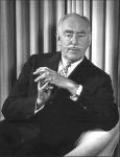The recent discovery of the hull of the battleship Nevada recalls her dramatic action at Pearl Harbor and ultimate revenge on D-Day as the first ship to fire on the Nazis.
Editor's Note: Don't miss the first half of this essay, Two Hours in Hell at Pearl Harbor. Author Ed Offley, after serving in the Navy during Vietnam,
USS Nevada was the only battleship to get underway during the attack at Pearl Harbor. The recent discovery of the ship's hull revived interest in her dramatic story.
Editor's Note: After serving in the Navy during Vietnam, Ed Offley reported on Naval issues for three decades for The Ledger-Star in Norfolk and The Seattle Post-Intelligencer, and was Editor-in-Chief of Stars & Stripes.
In the early 1950s, top secret efforts led to the first submarine trips to the North Pole by USS Nautilus and USS Skate in 1957 – dramatic successes that rivaled the Soviet Union's Sputnik that year – and shifted the balance of strategic power.
When the first African-Americans to crew a U.S. warship sailed into the war-tossed North Atlantic, they couldn't have known it would take fifty years to gain honor in their own country
I sometimes felt like I was swimming against a very strong tide when doing research for my book on the men of the USS Mason. Very few people had ever heard of the first ship in the U.S. Navy manned by African-American sailors.
Tall ships and U.S. Navy vessels sailed into Baltimore Harbor past Fort McHenry to commemorate the bicentennial of the War of 1812
Square-riggers, schooners, and sleek gray warships from around the world converged on Baltimore the second week of June for the “Star Spangled Sailabration” commemorating the bicentennial of the War of 1812’s start.
Not until the Civil War was about over did the U.S. Navy manage to put a halt to the South’s imports
America’s naval tradition is as old as America itself, and an amazing number of the ships that forged it are still afloat.
Something about ships accentuates the human experience, most obviously because of the breadth of activity that has taken place within such small spaces.
Forty years ago the USS Maddox fought the first battle of America’s longest war. How it happened—and even if it happened—are still fiercely debated.
From the combat information center (CIC) of the Destroyer USS Maddox, Commodore John Herrick radioed: “Am being approached by high speed craft with apparent intention of torpedo attack.
Powered flight was born exactly one hundred years ago. It changed everything, of course—but most of all, it changed how we wage war.
Walter Boyne’s résumé makes for unusual reading. He is the author of 42 books and one of the few people to have had bestsellers on both the fiction and the nonfiction lists of The New York Times.
It is a place of noble harbors, a convergence of strong rivers and a promontory commanding a wind-raked bay; a shoreline enfolding towns older than the Republic and the most modern and formidable naval base on earth; a spot where a four-hour standoff between two very peculiar ships changed the course of warfare forever—and the breeding ground of crabs that people travel across the country to eat. Fred Schultz explains why the fifth annual American Heritage Great American Place Award goes to
Twice wholly destroyed and twice rebuilt, Norfolk is again redefined and in the midst of an ambitious rehabilitation.
THE ATOLL WHERE THE TIDE OF THE PACIFIC WAR TURNED IS NOW BOTH A STIRRING
HISTORICAL LANDMARK AND A STUNNING WILD LIFE REFUGE.
THE NEGLECTED EPIC OF ANDREW JACKSON HIGGINS
Tough, nimble, and pound for pound the most heavily armed ships in the U.S. Navy, PT boats fought in the very front line of the greatest sea war in history. But even today hardly anyone understands what they did.
One night in August 1943 PT-105 was drifting on station in the Solomon Islands—specifically, two miles southeast of Vella Lavella, three miles north of Gizo, and fifteen miles west of Kolombangara, all of which were enemy-occupied.
A TALE OF PERIL, COURAGE, and gross ingratitude on the old China station
In the age of sail every fighting ship had its complement of powder monkeys, boys in their early teens or even younger whose duty was to carry bags of gunpowder from the ship’s magazines to her cannon in time of battle. The Navy used powder monkeys for decades, but they disappeared long before the war with Spain, displaced by advances in ordnance and humanitarian objections to exposing children to combat.
Unloved and unlovely, the fragile boats of the “Tinclad Navy” ventured, Lincoln said, “wherever the ground was a little damp,” and made a contribution to the Western war that has never been sufficiently appreciated
In the late summer and autumn of 1864 two brothers, Norman and George Carr, aged twenty-two and twenty-four respectively, left their upstate New York home of Union Springs to join the United States Navy. The motives that sent them may have been complex.
The Thirteenth Amendment outlawed slavery in 1865, but right on into this century sailors were routinely drugged, beaten, and kidnapped to man America’s mighty merchant marine
William Davis, a cabinet-maker, left his home near Great Salt Lake in the Utah Territory in the mid-1870s and headed for Northern California, a fast-growing region where he hoped to earn up to six dollars a day by adapting his expertise to ship carpentry.
The author entered the conquered capital days after the surrender to meet high officers of the Imperial Navy
Fifty years ago, in the summer of 1945, I was a naval officer in Norfolk, Virginia, contemplating my inevitable return to the Western Pacific, when two bombs were dropped, the Soviets entered the war, and the Japanese emperor prevailed on his government to th
They padded aboard submarines and proved themselves steadfast in boredom and in battle. During the worst of war these canine mascots brought their shipmates some of the comfort of home.
SAILORS HAVE BEEN TAKING DOGS TO SEA SINCE A PAIR OF canines shipped out with Noah. Nevertheless, the picture of the floppy-eared poodle, looking as jaunty and confident as the young submariners who surrounded her, surprised me.
Revisiting the seas where American carriers turned the course of history, a Navy man re-creates a time of frightful odds and brilliant gambles.
Some memories are good and some bad, but the fact is that they change over the years. All of us who were part of it can recall how angry we were about the war against the Axis Powers. We were mad at all of it: Pearl Harbor, enemy atrocities, everything.
The American army that beat Hitler was thoroughly professional, but it didn’t start out that way. North Africa was where it learned the hard lessons—none harder than the disaster at Kasserine. This was the campaign that taught us how to fight a war.
There was no light. Most of the soldiers in the boats couldn’t see anything, but they knew they must be close because the wind offshore brought the smell of charcoal smoke and dry grass. The first assault troops landed sometime after eight bells.
Giving the men who died aboard America’s first battleship a decent funeral took fourteen years, three-quarters of a million dollars, and some hair-raising engineering. But in the end, they did it right.
On the evening of February 15, 1898, the U.S. battleship Maine rode peacefully at her mooring in Havana Harbor.
A novelist and historian takes us on a tour of the Academy at Annapolis, where American history encompasses the history of the world.
Watery is the first word that comes to mind as you enter the main gate of the U.S. Naval Academy, at the foot of the Maryland town that has become the school’s other name, Annapolis.
Seventy-five years ago a powered kite landed on a cruiser. From that stunt grew the weaponry that has defined modern naval supremacy.
I enjoyed Professor Elting E. Morison’s article “Inventing a Modern Navy” (June/July issue), but a training manual on repelling boarders should not be used as an example of an idea that was outmoded by the late nineteenth century.
Chaos and farce and catastrophe played a big part. But so did a few men of vision.
A former Marine recalls the grim defense of Guadalcanal in 1942
July 1942. Winter in Wellington, New Zealand, brought long, slanting sheets of rain that drenched the U.S. Navy transports looming huge and dark along the city’s docks. The men of the 1st Marine Division labored around the clock to combat-load the ships.
Two letters from a Navy lieutenant to his wife tell the story of the last hours of World War II
YOKOSUKA 9·4·45
My dear:
His job was to destroy German submarines. To do it, they gave him twelve men, three machine guns, four depth charges, and an old wooden fishing schooner with an engine that literally drove mechanics mad.
On July 6, 1942, I was standing on the fantail of the minesweeper Fulmar off Portland, Maine, when the signal tower started blinking away. By the time I could get to the bridge, the message had already been typed up.
The U.S. Navy’s first submarine was scrapped half a century ago. But now we have been given a second chance to visit a boat nobody ever expected to see again.
IN 1930 THE United States Navy’s first submarine was hauled away from the Bronx park where it had long been on display and was knocked into scrap by a salvage company that had paid one hundred dollars for the privilege.
If he’d been the closest companion of the president of IBM, you might happen across his name in a privately printed memoir. But LeMoyne Billings was John Fitzgerald Kennedy’s best friend from Choate to the White House—and that makes him part of history.
CROATE, 1935





